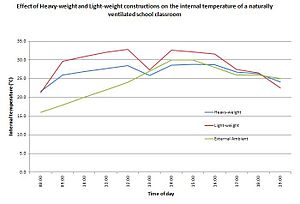[ad_1]
In building design, thermal mass is a property of the mass of a building which enables it to store heat, providing “inertia” against temperature fluctuations. It is sometimes known as the thermal flywheel effect. For example, when outside temperatures are fluctuating throughout the day, a large thermal mass within the insulated portion of a house can serve to “flatten out” the daily temperature fluctuations, since the thermal mass will absorb thermal energy when the surroundings are higher in temperature than the mass, and give thermal energy back when the surroundings are cooler, without reaching thermal equilibrium. This is distinct from a material’s insulative value, which reduces a building’s thermal conductivity, allowing it to be heated or cooled relatively separate from the outside, or even just retain the occupants’ thermal energy longer.
Scientifically, thermal mass is equivalent to thermal capacitance or heat capacity, the ability of a body to store thermal energy. It is typically referred to by the symbol Cth and measured in units of J/°C or J/K (which are equivalent). Thermal mass may also be used for bodies of water, machines or machine parts, living things, or any other structure or body in engineering or biology. In those contexts, the term “heat capacity” is typically used instead. Read more…
[ad_2]
Source link






Leave a Reply
Want to join the discussion?Feel free to contribute!